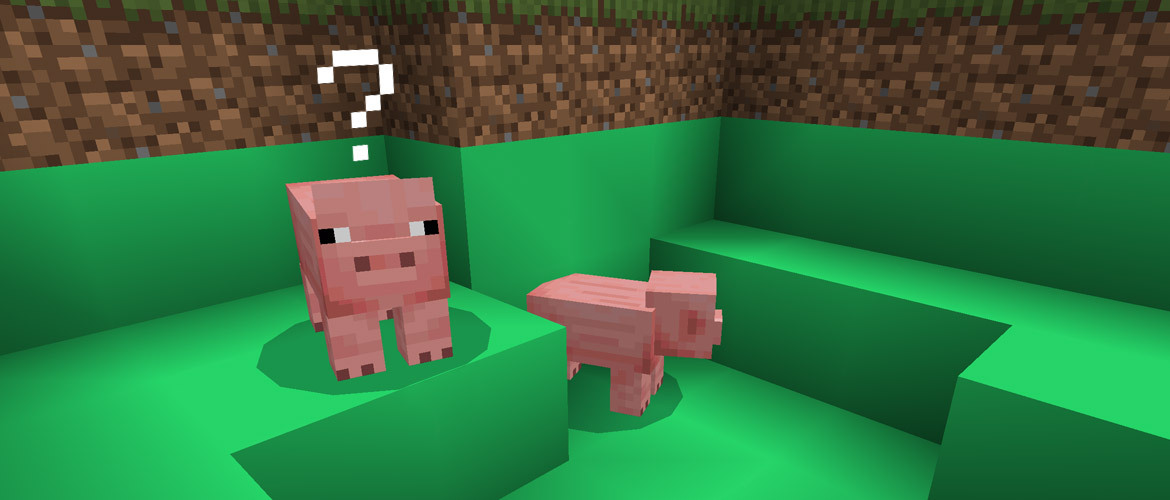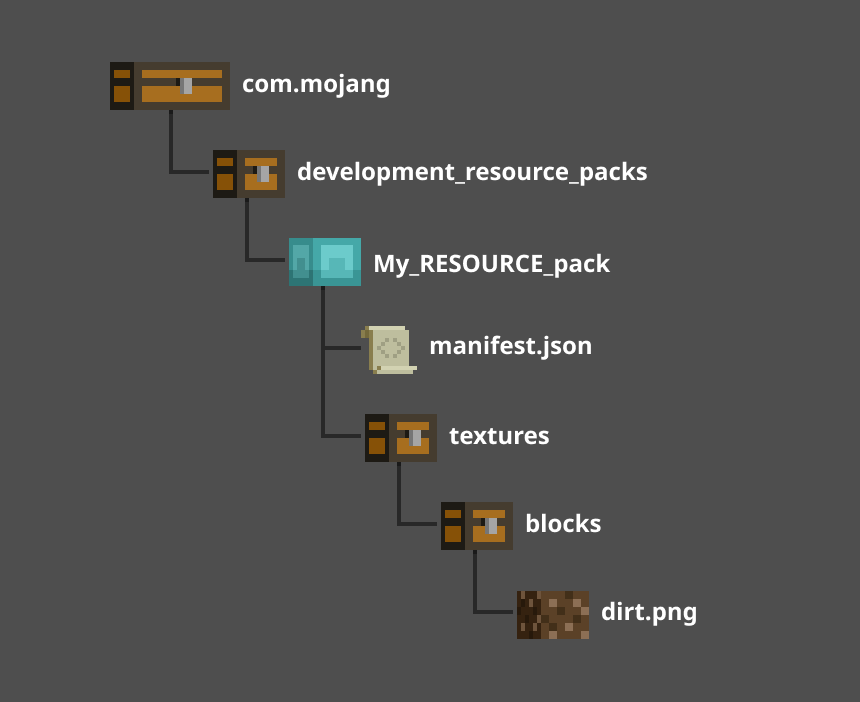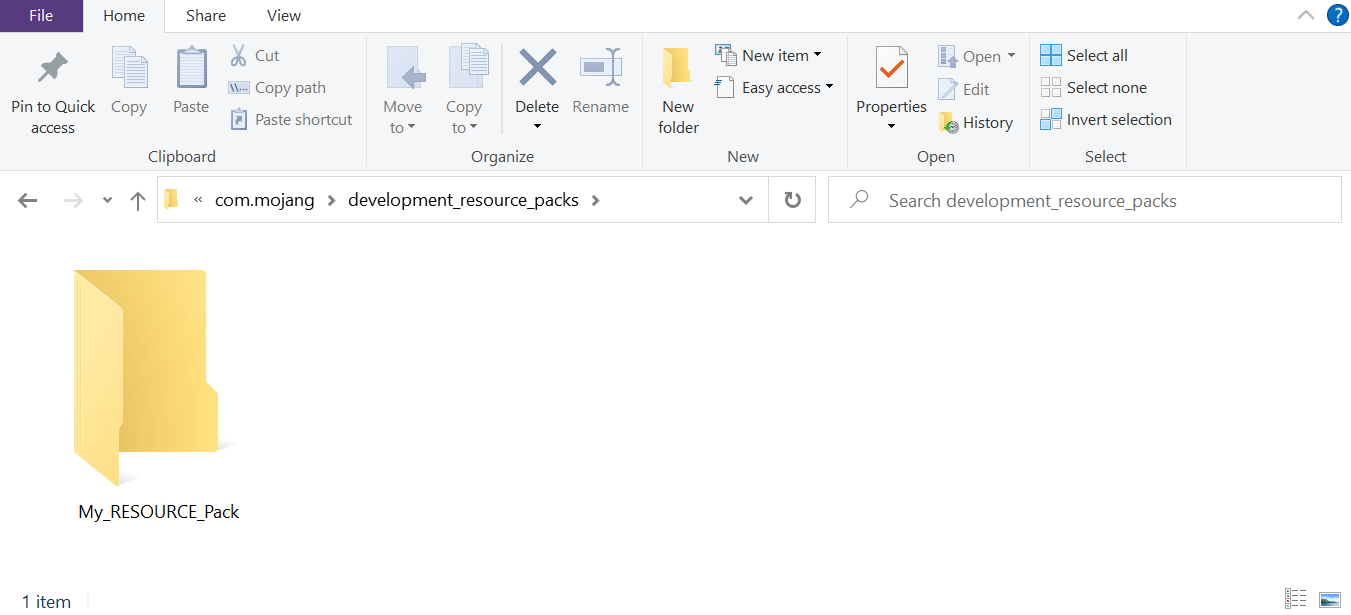Introduction to Resource Packs
Before building your first Add-On for Minecraft: Bedrock Edition, you need to create a pack to hold your custom content. There are two types of packs that a creator can make: resource packs and behavior packs. For this tutorial, we're going to be focusing on resource packs.
A resource pack is a folder structure that contains all of your custom models, sounds, textures, and other custom content.

In this tutorial, you will learn:
- How a resource pack is created.
- How a manifest file is created.
- How custom textures are loaded into Minecraft.
- The concept of Pack Stacking when working with Add-On content.
Sample Resource Pack
There is a sample resource pack available on the Minecraft samples Github. This pack may be used to understand the structure of resource packs and to check your work after you complete this tutorial.
Requirements
We recommend completing the following before beginning this tutorial:
Building the Resource Pack
For Minecraft to find and use your resource files, you must set up the folders and files in a specific way. This tutorial will guide you through creating this folder and file structure.

Create a Resource Pack Folder
We will start by creating a folder called My_RESOURCE_Pack. Technically you can name this folder anything you want, but the other folders have to be named exactly as specified in this tutorial so that Minecraft knows where to find the information.
- Open the com.mojang folder.
- Double-click the development_resource_packs folder to open it.
- Add a new folder and name it My_RESOURCE_Pack.
- Double-click the My_RESOURCE_Pack folder to open it.

Create a Manifest File
To load a resource pack into Minecraft, we need a manifest file. The manifest file is a JSON file that contains the following information:
- Description: In-game description of what the resource pack does.
- Name: In-game name of the resource pack.
- UUID: Universally Unique Identifier.
- Version: Version of the resource pack.
- Minimum Engine Version: Minimum required version of Minecraft for this pack to work properly.
Note
To learn more about how a manifest.json file works, see the Addons Reference manifest.json documentation.
Minecraft parses the information from the manifest file and displays it in the Add-On section of the game. Inside the file, the information is split into two separate sections: Header and modules. The header section contains the overall information for the pack, while the modules section contains the dedicated packages information. To create the manifest.json file:
- Right-click in the Explorer window, and select New > Text Document.
- Name it manifest.json.
- You will need to change the file extension from .txt to .json. If your Explorer window does not show file extensions, you can enable File Name Extensions under the View tab.

- You will need to change the file extension from .txt to .json. If your Explorer window does not show file extensions, you can enable File Name Extensions under the View tab.
- Double-click the manifest.json file to open it in a text editor.
- Copy and paste the following code into your file.
{
"format_version": 2,
"header": {
"description": "My dirt resource pack Add-On!",
"name": "My Resource Pack",
"uuid": "<FIRST GENERATED UUID>",
"version": [1, 0, 0],
"min_engine_version": [1, 16, 0]
},
"modules": [
{
"description": "My First Add-On!",
"type": "resources",
"uuid": "<SECOND GENERATED UUID>",
"version": [1, 0, 0]
}
]
}
UUID
A Universally Unique Identifier (UUID) is a unique number used to identification purposes. For Minecraft, the UUID is used to define a specific pack and to prevent any duplicate software from causing issues. For the header and modules, there will need to be two different UUID numbers entered in each of the "uuid" fields between the quotes. You can get UUIDs from an online UUID Generator such as https://www.uuidgenerator.net/.

- Copy and paste a UUID into the header section. The UUID will need to be pasted in the
"uuid":""field between the quotation ("") marks to be read correctly. - Refresh the webpage to generate a new UUID for use in the Modules section.
- Copy and paste the new UUID into the modules section in the
"uuid"field between the quotation marks. - Save the manifest.json file.
Changing the Dirt Block
With the manifest file completed, you can now start adding custom content to Minecraft. Let's get started by applying a new texture to the Vanilla dirt block. The first part of the process involves creating a folder structure to hold the custom texture.
- Open the My_RESOURCE_Pack folder and create a folder named textures.
- Double-click the textures folder to open it.
- Open the textures folder and create a folder named blocks.
- Double-click the blocks folder to open it.
Creating the texture
Now that the folder structure is created, we can start adding some custom textures. This green square is an example of the type of file created using the following steps.

You can download this green block and save it in your blocks folder or follow these steps to create your texture:
- Open up an image editor such as MS Paint.
- Go to the File menu and select Properties.
- Set the Width and Height to 16 pixels each.
- Click OK.
You can now design a pattern or any artwork in the editor. To make the green square, a simple fill color was added.
Note
MS Paint is used in this example for quick and easy access, but you will need to use a different graphics editor for more advanced graphic features like transparency effects or .tga file support.
- After editing the texture, go to the File menu and select Save As.
- Choose the PNG picture option.
- In the Save As dialog box, navigate to the blocks folder.
- Save the file as dirt.png.
Testing the pack
Now that the pack has both a manifest file and a texture file, you can launch Minecraft and test your new resource Add-On.
Important
Pack Stacking is how content is loaded on top of Vanilla content, causing each object that has the same name in both packs to be overwritten by the latest applied pack. In our example, the original dirt texture is overwritten by the custom texture.
If another pack that uses the dirt.png file is loaded after My_RESOURCE_Pack, then Minecraft will use that file instead.
Your custom texture will be used on every dirt.png block in the world, but it will not be used on blocks of dirt with grass on them because those blocks have a different name.
- Launch Minecraft and select Play.
- Select Create New World.
- Under Settings, scroll down to the Add-Ons section.
- Click on Resource Packs to see all available packs.
- Click the MY PACKS drop-down.
- Select My RESOURCE Pack and click Activate to add the resource pack to the world.
- Click Create.

Troubleshooting
Resource pack woes? Don't worry, troubleshooting is a normal part of any development process.
You can use the sample resource pack on the Minecraft samples Github site to check the structure of your resource pack.
Your Resource Pack Does Not Appear in Minecraft
If your resource pack does not appear in the Add-Ons section of a world, the issue may be a malformed manifest.json file. Let's investigate.
- Are there two different UUIDs in the
manifest.jsonheader and modules section? See the UUID section for more information. - Have you turned on file extensions and paths? If your Explorer window does not show file extensions, you can enable File Name Extensions under the View tab.
- Double-check JSON curly braces and brackets. JSON linting tools can help.
Resource Pack Shows Up, Content Doesn't Work
- Check that the
texturesfolder is in the right place, and spelled correctly. Then check theblocksfolder as well. - Download the Vanilla resource pack and try adding your block to the existing
textures/blocksfolder. - Make sure the new texture file is named the same as the Vanilla texture it's replacing.
- Move your pack above others to ensure your
dirt.pngtexture is loaded before other resource packs.
What's Next?
With a custom texture now a part of your Minecraft world, it's time to see how behavior packs alter existing entity behaviors. In our next tutorial, you will add aggressive behavior to a normally peaceful cow.
To see examples of unchanged resource and behavior files, check out the Minecraft Vanilla resource pack and Vanilla behavior Pack.
Feedback
Coming soon: Throughout 2024 we will be phasing out GitHub Issues as the feedback mechanism for content and replacing it with a new feedback system. For more information see: https://aka.ms/ContentUserFeedback.
Submit and view feedback for